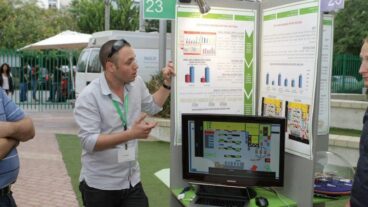TransScan’s breast imaging device is aimed at the market for women under 40 for whom mammograms are not recommended.Breast cancer specialists are looking for a new way of detecting tumors in women under 40 that are less expensive, less time consuming and potentially less harmful than traditional mammograms and more accurate than manual breast exams.
An Israeli company, known as TransScan Medical, is positioning its three-year-old product to answer this need using a technique called electrical impedance imaging. This method is based on passing a tiny electrical current through the body and measuring the differences in resistance between normal and cancerous tissue. The cancerous tissue reveals itself by passing the current more easily.
More than 200,000 women are diagnosed annually with breast cancer and about 45,000 die from the disease each year. Women under 40 have a significantly lower incidence of cancer than older women, but when the disease strikes them it is 10 times more deadly.
Mammograms for women in the 25 to 40 age group have always been a problem because X-rays do not see through the dense breast tissue of pre-menopausal women very well. In addition, since younger women are at less risk for breast cancer, they’re reluctant to risk possible harm from the radiation they would receive from regular mammograms.
Women under 40 who have no family history of breast cancer largely rely on manual exams carried out by their gynecologists and on self-breast exams that are recommended on a monthly basis. This has limitations both because of the room for human error and because by the time hands can identify a mass, it is often, at least in young women, at a later stage of cancer.
“Younger women need a quick, simple, cheap, low-risk breast exams,” said TransScan chief executive Ron Ginor. “These exams can’t be painful, can’t be expensive, and can’t expose them to risk – and the ‘false positive rate’ has to be low.”
TransScan’s device is easy to use and painless and takes about five minutes to complete, Ginor said. After a hand-held scan probe is placed on the breast, a red light flashes if a tumor is detected and a green light flashes for a normal diagnosis. So far, 25,000 breast evaluations have been done during and subsequent to clinical trials. The device received U.S. Food and Drug Administration approval in 1999.
The machine is not cheap at $40,000 each, but the price is far lower than x-ray machines for mammograms or Magnetic Resonance Imaging devices.
TransScan is in the process of launching an extensive three-year study to prove its efficacy in locating early stage breast cancer in young women. To partially finance this study, it has applied for a $3 million grant from the National Institute of Health and the American Cancer Institute to scan 30,000 women.
The company hopes to use the machine in 50 gynecological clinics to prove how effective it is as an early detection device. TransScan estimates the machine will pick up on 30 to 40 percent more suspicious cancer markers in women in the 25 to 40 age group than manual breast exams. These markers that the manual exams would have missed would ordinarily remain undetected until the women received mammograms. Following diagnosis on the machine, women with the suspicious markers receive mammograms and ultrasound testing.
The company is hoping that this large study will give the technology increased recognition and credibility and that, subsequently, word of mouth will help sales.
“If the study provides enough information to confirm the device’s accuracy in detecting cancer, it will become an important device,” said Dr. Eyal Schiff, chairman of the division of obstetrics and gynecology at Sheba Medical Center in Tel Hashomer, Israel. “Its big advantage is that it is very easy to use, it is ambulatory and it is a test that can be performed in an outpatient clinic.
“Physicians who are afraid that they may miss something (with their hands) will be happy to use something more accurate.”












